(完整版)初中英语说课稿(英文版).doc
初中英语说课稿(英文版模板)(完整资料).doc
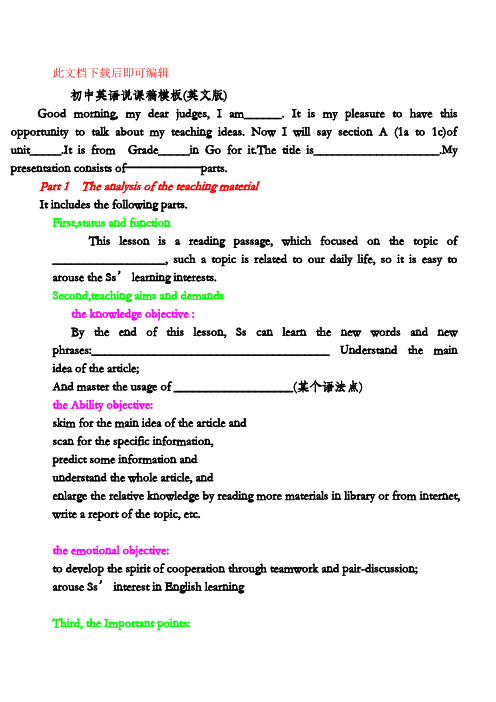
此文档下载后即可编辑初中英语说课稿模板(英文版)Good morning, my dear judges, I am______. It is my pleasure to have this opportunity to talk about my teaching ideas. Now I will say section A (1a to 1c)of unit_____.It is from Grade_____in Go for it.The title is____________________.My presentation consists of——————parts.Part 1 The analysis of the teaching materialIt includes the following parts.First,status and functionThis lesson is a reading passage, which focused on the topic of __________________, such a topic is related to our daily life, so it is easy to arouse the Ss’ learning interests.Second,teaching aims and demandsthe knowledge objective :By the end of this lesson, Ss can learn the new words and new phrases:______________________________________ Understand the main idea of the article;And master the usage of ___________________(某个语法点)the Ability objective:skim for the main idea of the article andscan for the specific information,predict some information andunderstand the whole article, andenlarge the relative knowledge by reading more materials in library or from internet, write a report of the topic, etc.the emotional objective:to develop the spirit of cooperation through teamwork and pair-discussion;arouse Ss’ interest in English lear ningThird, the Important points:to get an overall understanding of the whole text,and develop their reading skills such as anticipating, skimming, scanning, summarizing language points…..…(具体课型用具体例子阐述)the usage of the______________________( 语法或句型)Fouth the Difficult points:Are enable the Ss to use the new words and phrases to express their ideas in daily life, and develop the ability of skimming and scanning.master the usage of ____________________________( 语法或句型)根据教学过程设计的内容来决定)Part 2 The analysis of studentsThe Ss have learned English for some years. They understand some words and simple sentences. They are curious, active, and fond of game, competition, and various activities. They enjoy learning through cooperation in a relaxing atmosphere.Part 3 Teaching methodsIn this lesson, My teaching methods includecommunicative teaching method, and task-based teaching methods. Besides, a computer, blackboard, a tape recorder, OHP and powerpoint are needed as the teaching aids.Part 4 Teaching proceduresThere are five steps in my teaching procedures.Step1Warming-up and leading in (3mins)Free talk; talk something related the topic of the article.show pictures .Purpose: activate the Ss to regard the topic of ___________________(主题) and create a relaxing atmosphere.Step2Pre-reading (10mins)There are 2tasks for the Ss.First,Do a guessing game.Show some funny pictures and sentences on PPT and then ask the Ss toGuess the meaning of the new words. Then ,ask some students to answer their key.right or wrong,d on’t tell them,now.let them f ind by themselves when studying the test.Second ,Practice the new words and phrases:Match the new words and phrases with the Chinese meanings. The left is English words and phrases,the right is Chinese meanings,ask some students to answer. Purpose: through guessing, to arouse Ss learning interest, and help them to learn the new words and phrases which they may come across while reading, pave the way for the following learning .Step3While- reading (15mins)Listen to the tape There are two tasks for the Ss.first reading:Ss read the article as quickly as they can and try to get the general idea by answer the following questions.Q1: who/ when/ what/ ……….second reading: pair-discussionSs read the article more carefully, and then discuss with their partners to finish the exercises .T he two tasks are aim to develop Ss’ reading ability. And then get a deep understanding of the article.Step 4 Post-reading (10mins)1)Group discussion: fill in the blanksSs discuss the article with their group members, and find out the language points, such as the key words, phrases, and sentence structures in the article.And then fill in the blanks in a short passage present on the PPT. The short passage is made up from the article, and the answers are the language points in thislesson.After check the answers, I will help the Ss to summarize the language points. 2)Retell:(As the students retell the key words。
初中英语全英说课稿优秀9篇
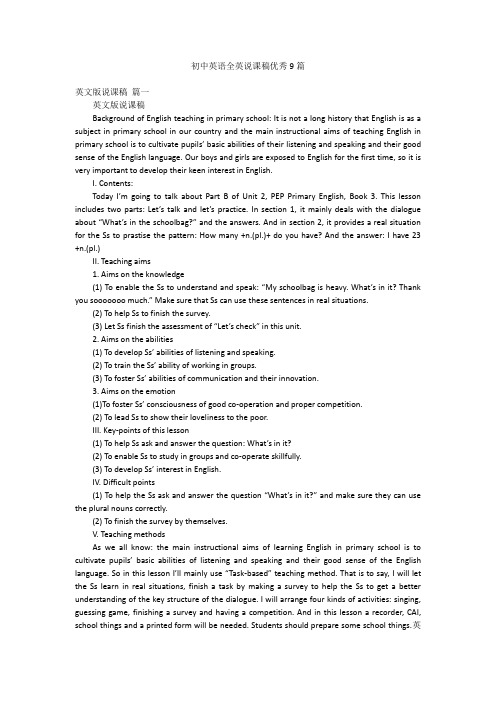
初中英语全英说课稿优秀9篇英文版说课稿篇一英文版说课稿Background of English teaching in primary school: It is not a long history that English is as a subject in primary school in our country and the main instructional aims of teaching English in primary school is to cultivate pupils’ basic abilities of their listening and speaking and their good sense of the English language. Our boys and girls are exposed to English for the first time, so it is very important to develop their keen interest in English.I. Contents:Today I’m going to talk about Part B of Unit 2, PEP Primary English, Book 3. This lesson includes two parts: Let’s talk and let’s practice. In section 1, it mainly deals with the dialogue about “What’s in the schoolbag?” and the answers. And in section 2, it provides a real situation for the Ss to prastise the pattern: How many +n.(pl.)+ do you have? And the answer: I have 23 +n.(pl.)II. Teaching aims1. Aims on the knowledge(1) To enable the Ss to understand and speak: “My schoolbag is heavy. What’s in it? Thank you sooooooo much.” Make sure that Ss can use these sentences in real situations.(2) To help Ss to finish the survey.(3) Let Ss finish the assessment of “Let’s check” in this unit.2. Aims on the abilities(1) To develop Ss’ abilities of listening and speaking.(2) To train the Ss’ ability of working in groups.(3) To foster Ss’ abilities of communication and their innovation.3. Aims on the emotion(1)To foster Ss’ consciousness of good co-operation and proper competition.(2) To lead Ss to show their loveliness to the poor.III. Key-points of this lesson(1) To help Ss ask and answer the question: What’s in it?(2) To enable Ss to study in groups and co-operate skillfully.(3) To develop Ss’ interest in English.IV. Difficult points(1) To help the Ss ask and answer the question “What’s in it?” and make sure they can use the plural nouns correctly.(2) To finish the survey by themselves.V. Teaching methodsAs we all know: the main instructional aims of learning English in primary school is to cultivate pupils’ basic abilities of listening and speaking and their good sense of the English language. So in this lesson I’ll mainly use “Task-based” teaching method. That is to say, I will let the Ss learn in real situations, finish a task by making a survey to help the Ss to get a better understanding of the key structure of the dialogue. I will arrange four kinds of activities: singing, guessing game, finishing a survey and having a competition. And in this lesson a recorder, CAI, school things and a printed form will be needed. Students should prepare some school things.英文版英语说课稿VI. Teaching procedures and purposes of my designing.I’ll finish this lesson in five steps.Step 1. Warm-up and preview1. Free talk between T and Ss about things in the classroom.2. Sing the song together: Books and pencils.3. Do some TPR, for example: Show me your English book. Show me your crayon.4. Review the numbers by asking: “How many crayons do you have?”Purpose: It is important to form a better English learning surrounding for the Ss by singing and doing some total physical response and at the same time it provides situations to review learned knowledge for the next step.Step 2. PresentationNow I’ll mainly talk about this step.1. Present the pattern: “My schoolbag is heavy.” “What’s in it?.”(1) Show a bag and say: “Look! I have a bag.” Carry it and say: “Oh, it is heavy. My schoolbag is heavy.” Help the Ss understand the meaning with the help of my body language. Then lead the Ss to read the sentence. Make sure they can say it correctly.(2) T: My schoolbag is heavy.Open the bag and say: “What’s in it? What’s in my schoolbag?”Take out a Chinese book. Then do the action again. Let the Ss read the sentence.2. Play a guessing game. Divide the whole class into four groups to have a competition.Let them guess: What’s in the bag? How many? Purpose: To present the key structures one by one is much easier for the Ss to learn and grasp the meanings. Proper competition can arouse the Ss’ interest in English learning.3. With the help of the CAI to present the dialogue. Set a situation to help Ss understand: Two Ss are coming. One girl is carrying a heavy bag on her back. They are talking.Girl: My schoolbag is heavy.Boy: What’s in it?Girl: 20 story-books, 32 pencil, 9 rulers, 12 crayons and 30 picture-books. Etc.Boy: What will you do?Girl: They are for the poor.Boy: Great! I’ll bring some school things too.The boy comes back home and puts a lot of things into the bag. Then he goes to school again and gives them to a teacher. While he is taking them out, he is counting the numbers of all things. The teacher says: Thank you soooooooo much.4. Mention that we should take care of the poor.5. Play the cassette. Let the Ss listen and imitate the dialogue.Pay attention to their pronunciation and intonation. Purpose: CAI can provide a real situation for the Ss to understand the dialogue and the relationships between people better. Tell the Ss we should show our loveliness to the Ss.Step 3. PracticeDivide Ss into groups of six children. Each one would finish the printed form by asking and answering: How many storybooks do you have? Find out which group finishes faster. Story books picture-books sharpeners crayons pencils erasers pencil-cases rulers Chen Jie 8 24 3 32 26 4 1 3Purpose: Task-based teaching method is used here to develop Ss’ ability of communication and also their ability of co-operation will be well trained.Step 4. AssessmentHelp Ss finish “Let’s check” of this unit and workbook.Purpose: To check the knowledge Ss have learned in this period.Step 5. Add-activity1. Let Ss tell each other how many school things they have after class. Tell their parents how many school things they have at home.2. Take care of everything they have.Purpose: Revision is so important that Ss should speak English as much as they as in class or after class. It is necessary for the Ss to do some extensive exercises after class to consolidate the knowledge they learned.英文版英语说课稿初中英语说课稿篇二今天我的说课内容是新目标英语八年级上册第四单元第一课时。
初中英语全英说课稿(优秀5篇)
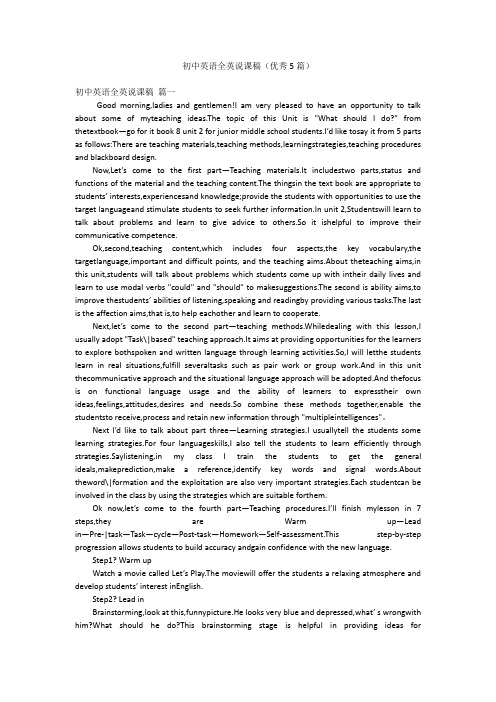
初中英语全英说课稿(优秀5篇)初中英语全英说课稿篇一Good morning,ladies and gentlemen!I am very pleased to have an opportunity to talk about some of myteaching ideas.The topic of this Unit is "What should I do?" from thetextbook—go for it book 8 unit 2 for junior middle school students.I’d like tosay it from 5 parts as follows:There are teaching materials,teaching methods,learningstrategies,teaching procedures and blackboard design.Now,Let’s come to the first part—Teaching materials.It includestwo parts,status and functions of the material and the teaching content.The thingsin the text book are appropriate to students’ interests,experiencesand knowledge;provide the students with opportunities to use the target languageand stimulate students to seek further information.In unit 2,Studentswill learn to talk about problems and learn to give advice to others.So it ishelpful to improve their communicative competence.Ok,second,teaching content,which includes four aspects,the key vocabulary,the targetlanguage,important and difficult points, and the teaching aims.About theteaching aims,in this unit,students will talk about problems which students come up with intheir daily lives and learn to use modal verbs "could" and "should" to makesuggestions.The second is ability aims,to improve thestudents’ abilities of listening,speaking and readingby providing various tasks.The last is the affection aims,that is,to help eachother and learn to cooperate.Next,let’s come to the second part—teaching methods.Whiledealing with this lesson,I usually adopt "Task\|based" teaching approach.It aims at providing opportunities for the learners to explore bothspoken and written language through learning activities.So,I will letthe students learn in real situations,fulfill severaltasks such as pair work or group work.And in this unit thecommunicative approach and the situational language approach will be adopted.And thefocus is on functional language usage and the ability of learners to expresstheir own ideas,feelings,attitudes,desires and needs.So combine these methods together,enable the studentsto receive,process and retain new information through "multipleintelligences"。
初中英语说课稿模板全英文
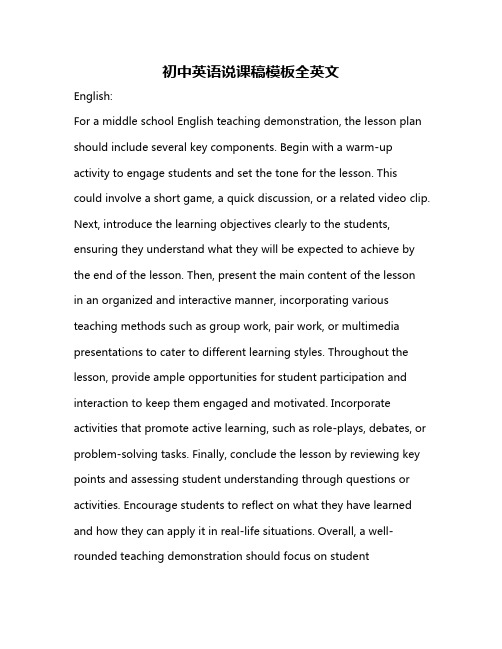
初中英语说课稿模板全英文English:For a middle school English teaching demonstration, the lesson plan should include several key components. Begin with a warm-up activity to engage students and set the tone for the lesson. This could involve a short game, a quick discussion, or a related video clip. Next, introduce the learning objectives clearly to the students, ensuring they understand what they will be expected to achieve by the end of the lesson. Then, present the main content of the lessonin an organized and interactive manner, incorporating various teaching methods such as group work, pair work, or multimedia presentations to cater to different learning styles. Throughout the lesson, provide ample opportunities for student participation and interaction to keep them engaged and motivated. Incorporate activities that promote active learning, such as role-plays, debates, or problem-solving tasks. Finally, conclude the lesson by reviewing key points and assessing student understanding through questions or activities. Encourage students to reflect on what they have learned and how they can apply it in real-life situations. Overall, a well-rounded teaching demonstration should focus on studentengagement, clear learning objectives, interactive teaching methods, and opportunities for reflection and assessment.中文翻译:初中英语教学示范课应包括几个关键组成部分。
初中英语说课稿全英文版

初中英语说课稿全英文版Good morning everyone。
my name is Zhang Meiying and I am from Huishe Middle School。
It is an honor to be here today to present my lesson on Sports Star XXX.In Part 1.I will XXX I will be teaching is the fourth d of Unit 6.which XXX.Next。
in Part 2.I will XXX the level and needs of the students in order to XXX.In Part 3.I will analyze the teaching methods。
There are us methods that can be used to teach the topic。
and I will discuss XXX.Part 4 will focus on the analysis of XXX students on how to study and XXX.In Part 5.I will discuss the XXX.Finally。
in Part 6.I will present the blackboard design。
This will include visual aids and diagrams to enhance the students' understanding of the topic.Overall。
XXX XXX material。
students。
methods。
studying ways。
teaching res。
and blackboard design。
XXX.XXX knowledge aims。
全英文初中英语说课稿模板
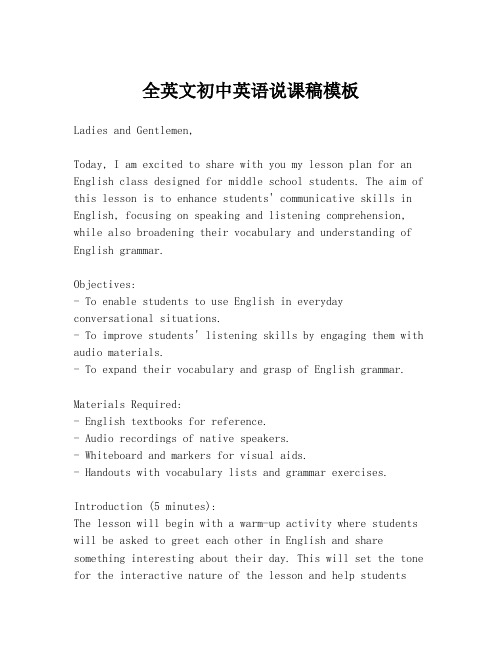
全英文初中英语说课稿模板Ladies and Gentlemen,Today, I am excited to share with you my lesson plan for an English class designed for middle school students. The aim of this lesson is to enhance students' communicative skills in English, focusing on speaking and listening comprehension, while also broadening their vocabulary and understanding of English grammar.Objectives:- To enable students to use English in everyday conversational situations.- To improve students' listening skills by engaging them with audio materials.- To expand their vocabulary and grasp of English grammar.Materials Required:- English textbooks for reference.- Audio recordings of native speakers.- Whiteboard and markers for visual aids.- Handouts with vocabulary lists and grammar exercises.Introduction (5 minutes):The lesson will begin with a warm-up activity where students will be asked to greet each other in English and share something interesting about their day. This will set the tone for the interactive nature of the lesson and help studentsfeel comfortable using English.Vocabulary Building (10 minutes):Next, we will delve into a new set of vocabulary wordsrelated to our topic for the day. I will use flashcards and images to make the learning process more engaging. Students will be encouraged to use these words in sentences to reinforce their understanding.Grammar Focus (15 minutes):After vocabulary building, we will move on to the grammar section. Today's focus will be on the present continuous tense, which is essential for describing actions happening at the moment of speaking. I will provide clear explanations, examples, and conduct drills to ensure students can applythis tense correctly.Listening Practice (15 minutes):Listening to English is crucial for developing an ear for the language. Students will listen to a short audio clip of a conversation between two native speakers. After the listening exercise, we will discuss the content and answer comprehension questions to check their understanding.Speaking Activity (15 minutes):To apply what they have learned, students will participate in a role-play activity. They will be divided into pairs and given a scenario to act out using the new vocabulary and grammar structures. This will allow them to practice speaking English in a fun and supportive environment.Conclusion (5 minutes):The lesson will conclude with a quick review of the day's learning objectives and a summary of the key points. I will also provide feedback on the students' performance during the speaking activity and offer suggestions for further practice.Homework Assignment:As homework, students will be asked to write a short paragraph using the new vocabulary and present continuous tense to describe an ongoing activity they are currently engaged in.I believe this lesson plan will be both educational and enjoyable for the students, providing them with ample opportunities to practice and improve their English skills.Thank you for your attention. I am looking forward to implementing this lesson and seeing the progress of our students.Best regards,[Your Name]。
初中英语说课稿英文版

初中英语说课稿英文版Good morning everyone,Today, I'm going to talk about my teaching plan for “Unit 8 Section A (2a-2e)” of Grade 7 English Textbook. The primary aims of this unit are to help students understand the topic of “Making and Keeping Friends” and to enable them to know how to make and keep friends.In this unit, I'll mainly focus on developing students' four skills of listening, speaking, reading and writing. More specifically, students will be able to do the following tasks. Firstly, they will be able to use “can” and “can't” correctly to express ability. Secondly, they will be able to describe people’s experiences. Thirdly, they will be able to talk about friendship. Fourthly, they will be able to read and understand short conversations about making new friends. Finally, they will be able to fill in a table using information from the text. In order to achieve the above goals, I will use the following teaching methods including:1. Task-based Language Teaching (TBLT). This kind of teaching focuses on students’ communication ability and all activities are centered on a task.2. Discussion. Through group discussion, students will beable to share their ideas and experiences.3. Role-play. This kind of activity helps students build their confidence and practice their speaking skill.4. Brainstorming. It's an effective way to help students to express their opinions.In conclusion, I believe that through these activities, I can help students develop their ability in using English, especially in understanding, speaking and writing.Thank you for listening. Now I'm open to questions.Thank you.。
初三英语说课稿英文版

初三英语说课稿英文版Introduction:Good morning, esteemed colleagues. Today, I am here to present my teaching plan for the English class of Grade 9 students. The focus of this lesson is on enhancing students' communicative competence and developing their critical thinking skills through a variety of interactive activities.Objectives:1. To enable students to understand and use a range of vocabulary related to daily activities.2. To improve students' listening and speaking skills through role-play and discussions.3. To encourage students to express their opinions on the importance of daily routines.Materials:- English textbooks for Grade 9- Handouts with new vocabulary and phrases- Audio recordings for listening exercises- Whiteboard and markersProcedure:Step 1: Warm-up (5 minutes)Begin the class with a quick warm-up activity. Have students stand up and perform a series of actions as you give commands in English, such as "touch your nose," "jump," or "clap yourhands." This will help to engage the students and activatetheir knowledge of basic vocabulary.Step 2: Vocabulary Introduction (10 minutes)Introduce new vocabulary related to daily activities using visual aids and examples. Distribute handouts with the new words and phrases, and have students repeat after you to practice pronunciation. Encourage them to make sentencesusing the new vocabulary.Step 3: Listening Exercise (15 minutes)Play an audio recording of a dialogue between two people discussing their daily routines. After the listening, ask students comprehension questions to check their understanding. This will help to develop their listening skills andreinforce the vocabulary they have just learned.Step 4: Speaking Practice (20 minutes)Divide the class into small groups and assign each group arole-play scenario based on daily routines. Students should use the new vocabulary and phrases to perform the role-play. This activity will give students a chance to practicespeaking in English and apply the language in a practical context.Step 5: Group Discussion (15 minutes)After the role-plays, initiate a class discussion on the importance of having a daily routine. Encourage students to share their opinions and experiences. This will help to develop their critical thinking and speaking skills.Step 6: Summary and Homework (5 minutes)Conclude the lesson by summarizing the key points and vocabulary covered. Assign homework that includes practicing the new vocabulary in written form and preparing a short presentation on their own daily routine to be shared in the next class.Assessment:Students will be assessed based on their participation in class activities, their role-play performance, and thequality of their homework and presentation.Conclusion:This lesson plan aims to provide a comprehensive approach to teaching English that not only focuses on languageacquisition but also on the development of communication and critical thinking skills. Thank you for your attention, and I look forward to implementing this plan in my classroom.。
初中人英语说课稿英文版

初中人英语说课稿英文版Introduction:Good morning, esteemed colleagues. Today, I am excited to present my lesson plan for a junior high school English class. The lesson is designed to engage students in active learning and to enhance their language skills through variousinteractive activities.Objectives:The primary objectives of this lesson are to:1. Improve students' listening and speaking skills through a dialogue practice.2. Introduce and practice new vocabulary related to daily routines.3. Encourage students to use English in real-life situations.Materials:- Textbook with the dialogue for the day- Whiteboard and markers- Handouts with the dialogue and vocabulary list- Audio recording of the dialogue- Props or pictures to facilitate role-playProcedure:1. Warm-up (5 minutes)Begin the class with a quick warm-up activity. Ask studentsto share one thing they did this morning in English. Thiswill set the tone for the lesson and activate their background knowledge.2. Presentation (10 minutes)Introduce the new vocabulary words related to daily routines (e.g., wake up, brush teeth, have breakfast, go to school). Use pictures or props to help students understand the meaning of each word. Write the words on the board and have students repeat after you.3. Listening Practice (10 minutes)Play the audio recording of the dialogue for the day.Instruct students to listen carefully and to note any new vocabulary or phrases they hear.4. Reading Comprehension (10 minutes)After listening to the dialogue, have students read it intheir textbooks. Ask them to identify the main points and any unfamiliar words or phrases.5. Vocabulary Drill (5 minutes)Conduct a vocabulary drill to reinforce the new words. Use flashcards or the whiteboard to test students' knowledge ofthe vocabulary.6. Dialogue Practice (15 minutes)Divide the class into pairs and assign each pair a role inthe dialogue. Give them a few minutes to practice their lines. Then, have each pair perform the dialogue in front of the class.7. Role-play Activity (15 minutes)Expand on the dialogue by creating a role-play scenario where students use the new vocabulary in a similar context. For example, they could role-play a conversation between two friends discussing their daily routines.8. Group Discussion (10 minutes)Organize the class into small groups and have them discuss their daily routines in English. Encourage them to use the new vocabulary and to ask questions of each other.9. Wrap-up (5 minutes)Conclude the lesson by summarizing the key points and vocabulary. Ask students to reflect on what they have learned and to think about how they can apply this knowledge outside the classroom.Assessment:Students will be assessed based on their participation in the activities, their understanding of the new vocabulary, and their ability to use the language in the role-play and group discussion.Differentiation:For advanced students, provide more complex sentences or additional vocabulary to challenge them. For students who are struggling, offer additional support and practice with the basic vocabulary and sentence structures.Conclusion:This lesson plan aims to create an interactive and engaginglearning environment where students can practice their English skills in a meaningful way. By the end of the lesson, students should feel more confident in their ability to communicate in English about their daily routines. Thank you for your attention, and I look forward to implementing this plan in the classroom.。
初中英语说课稿全英文

初中英语说课稿全英文Introduction:Good morning, esteemed colleagues. Today, I am excited to share with you my lesson plan for a middle school English class. The lesson is designed to engage students in a variety of activities that will enhance their language skills and foster a love for learning.Objectives:The primary objectives of this lesson are to:1. Improve students' speaking and listening skills through interactive dialogues.2. Enhance their vocabulary by introducing new words in context.3. Develop their reading comprehension through a short story.4. Encourage creative writing by having students write a short paragraph based on the story.Materials:- English textbooks- Whiteboard and markers- Handouts with new vocabulary words- Audio recording of the short story- Writing paper and pencilsProcedure:1. Warm-up (5 minutes)Begin the class with a quick warm-up activity to get students thinking in English. I will ask students to share one thing they did over the weekend, using the present perfect tense.2. Vocabulary Introduction (10 minutes)Introduce new vocabulary words that are relevant to the theme of the lesson. Use flashcards or a PowerPoint presentation to display the words along with their meanings and pronunciation. Engage students in a matching game to reinforce learning.3. Listening Comprehension (15 minutes)Play an audio recording of a short story related to the new vocabulary. Before playing the recording, provide studentswith a list of key questions to listen for. After the first listening, discuss the answers as a class.4. Reading Comprehension (20 minutes)Distribute a printed copy of the short story. Have students read it silently and then answer comprehension questions in small groups. Encourage them to use the new vocabulary wordsin their discussions.5. Speaking Activity (15 minutes)Divide the class into pairs and have them act out a dialogue based on the short story. Each pair should create their own dialogue that includes the new vocabulary words.6. Writing Activity (15 minutes)Instruct students to write a short paragraph from the perspective of one of the characters in the story. Theyshould incorporate the new vocabulary words and express thecharacter's feelings or thoughts.7. Conclusion (5 minutes)Conclude the lesson by reviewing the objectives and summarizing the key points. Ask for volunteers to share their written paragraphs, providing feedback and praise.Assessment:Students will be assessed based on their participation in class activities, their ability to use the new vocabulary correctly, and the quality of their written paragraph.Differentiation:For advanced students, provide more complex sentences to create during the speaking activity. For struggling students, offer additional support with vocabulary and sentence structure during the writing activity.Closure:Thank you for your attention. I am looking forward to implementing this lesson and observing the progress of our students in their English language journey.。
初中英语全英文说课稿模板.doc
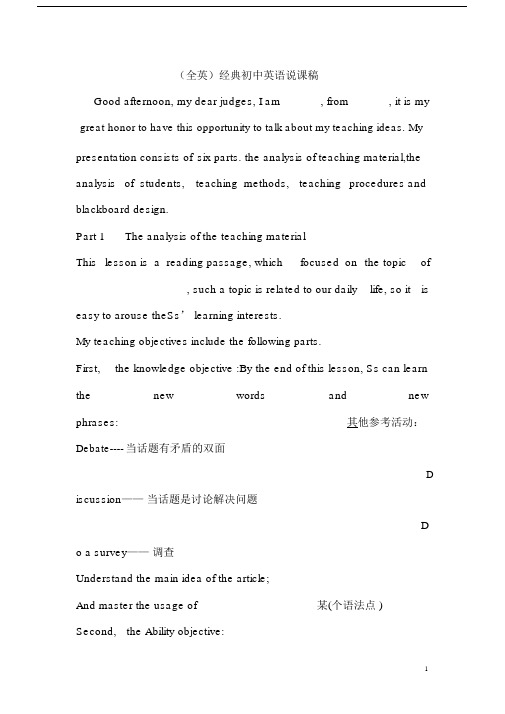
(全英)经典初中英语说课稿Good afternoon, my dear judges, I am ______, from ______, it is my great honor to have this opportunity to talk about my teaching ideas. My presentation consists of six parts. the analysis of teaching material,the analysis of students, teaching methods, teaching procedures and blackboard design.Part 1 The analysis of the teaching materialThis lesson is a reading passage, which focused on the topic of __________________, such a topic is related to our daily life, so it is easy to arouse theSs’ learning interests.My teaching objectives include the following parts.First, the knowledge objective :By the end of this lesson, Ss can learn the new words and new phrases: 其他参考活动:Debate---- 当话题有矛盾的双面D iscussion——当话题是讨论解决问题D o a survey——调查Understand the main idea of the article;And master the usage of ___________________某(个语法点 ) Second, the Ability objective:skim for the main idea of the article andscan for the specific information,predict some information andunderstand the whole article, andenlarge the relative knowledge by reading more materials in library orfrom internet, write a report of the topic, etc. Third , the emotionalobjective:to develop the spirit of cooperation through t eamwork and pair-discussion;arouse Ss’ interest in English learningFourth, the Cultural awarenessFifth ,the Important points:to get an overall understanding of the whole text,and develop their reading skills such as anticipating, skimming, scanning, summarizing language points ..(具体课型用具体例子阐述)the usage of the______________________(语法或句型 )While the Difficult points:Are enable the Ss to use the new words and phrases to express theirideas in daily life, and develop the ability of skimming and scanning.master the usage of ____________________________语(法或句型 )根据教学过程设计的内容来决定)Part 2The analysis of studentsThe Ss have learned English for some years. They understand some words and simple sentences. They are curious, active, and fond of game, competition, and various activities. They enjoy learning through cooperation in a relaxing atmosphere. Part 3 Teaching methodsIn this lesson, My teaching methods include audio-visual teaching method, communicative teaching method, and task-based teaching methods.Besides, a computer, blackboard, a tape recorder, a projector are needed as the teaching aids.Part 4Teaching proceduresThere are five steps in my teaching procedures. But before teaching, I will divide the whole class into 4 groups to do competitions while finish different tasks in this lesson.Step 1 Warming-up and leading in (3mins)Free talk; talk something related the topic of the article.参考活动:Brainstorming, setting the scene, show pictures etc.Purpose: activate the Ss to regard the topic of ___________________主(题) and create a relaxing atmosphere.Step 2 Pre-reading (10mins)There are 3 tasks for the Ss.(1)Do a guessing game.(2)Show some funny pictures and sentences on PPT and then ask the Ssto(3)Guess the meaning of the new words.Practice the new words and phrases:Match the new words and phrases with the Chinese meanings.Predicting: based on the title/ pictures on the text. (看具体情况而定 )Purpose: through guessing, to arouse Ss learning interest, and help themto learn the new words and phrases which they may come across whilereading, pave the way for the following learning and cultivate the ability of anticipating.{Meanwhile, pronunciation of some letter strings such as“ ea” (pe feast..) and “ er (cucumber” ⋯ )are highlighted so as to foster students’phonetic sensitivity.} (如果有音教学可渗透。
初中说课稿模板英语全英文
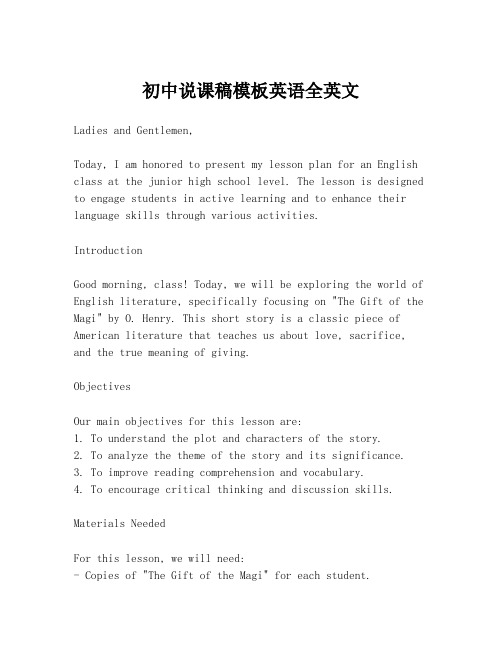
初中说课稿模板英语全英文Ladies and Gentlemen,Today, I am honored to present my lesson plan for an English class at the junior high school level. The lesson is designed to engage students in active learning and to enhance their language skills through various activities.IntroductionGood morning, class! Today, we will be exploring the world of English literature, specifically focusing on "The Gift of the Magi" by O. Henry. This short story is a classic piece of American literature that teaches us about love, sacrifice, and the true meaning of giving.ObjectivesOur main objectives for this lesson are:1. To understand the plot and characters of the story.2. To analyze the theme of the story and its significance.3. To improve reading comprehension and vocabulary.4. To encourage critical thinking and discussion skills.Materials NeededFor this lesson, we will need:- Copies of "The Gift of the Magi" for each student.- Whiteboard and markers.- Handouts with vocabulary words and comprehension questions. - A projector to display images or videos related to the story.Procedure1. Warm-up Activity (5 minutes): We will start with a quick vocabulary match game to review words related to the story. This will set the stage for our reading and discussion.2. Reading (20 minutes): Students will read the story silently, taking notes on the characters, plot, and any unfamiliar words.3. Vocabulary Review (10 minutes): After reading, we will review the vocabulary handout, ensuring that students understand the meaning of new words.4. Comprehension Check (10 minutes): We will go through the comprehension questions to ensure that students have grasped the main ideas of the story.5. Discussion (15 minutes): In pairs or small groups, students will discuss the theme of the story, the sacrifices made by the characters, and what they learned about the value of giving.6. Creative Writing (15 minutes): Students will write a short paragraph or a dialogue inspired by the story, focusing on a similar situation where they had to make a sacrifice forsomeone they cared about.7. Wrap-up (5 minutes): We will conclude the lesson by summarizing the key points discussed and reflecting on the importance of the story's message.AssessmentStudents will be assessed based on their participation in the discussion, the quality of their creative writing, and their understanding of the story's theme and vocabulary.ConclusionIn conclusion, this lesson aims to not only improve students' English language skills but also to impart valuable life lessons through the power of literature. I believe that by the end of this lesson, students will have a deeper appreciation for the story and its underlying message.Thank you for your attention, and I look forward to afruitful and engaging lesson.[End of Lesson Plan]。
完整版)初中英语说课稿(英文版)

完整版)初中英语说课稿(英文版)XXX。
students will XXX XXX.2)技能目标skill objectsXXX' ability to discover。
analyze。
and solve problems。
as well as improve their four language skills。
with a special emphasis on reading。
Students will learn to use Top-down model or Bottom-up model to XXX.3)情感态度目标affective objectsXXX' awareness of environmental issues and XXX them to take n to XXX.二、说教法Teaching methods1.任务型教学task-based teachingThe lesson will be taught using a task-based approach。
where students will be given a task to XXX/reading。
This will help them to apply the language XXX real-XXX.2.交互式教学XXXInteractive teaching methods will be used to XXX group ns。
role-plays。
and XXX.3.多媒体辅助教学multimedia-assisted teachingMultimedia tools such as videos。
pictures。
and online resources will be used to enhance students' understanding of the topic and engage their interest。
初中说课稿英文版.doc
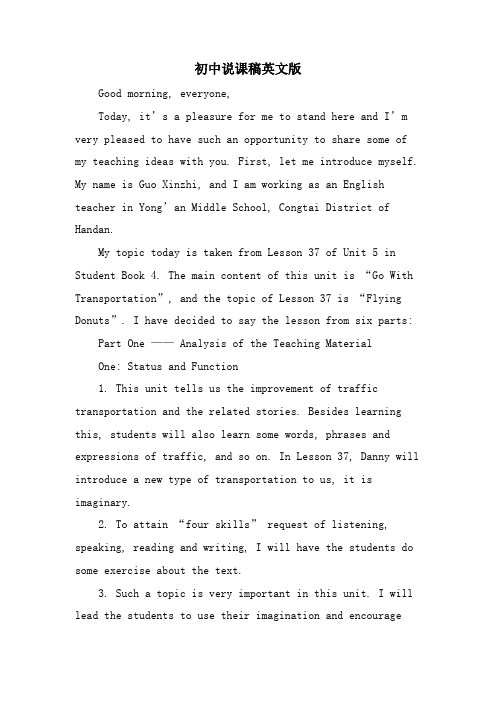
初中说课稿英文版Good morning, everyone,Today, it’s a pleasure for me to stand here and I’m very pleased to have such an opportunity to share some of my teaching ideas with you. First, let me introduce myself. My name is Guo Xinzhi, and I am working as an English teacher in Yong’an Middle School, Congtai District of Handan.My topic today is taken from Lesson 37 of Unit 5 in Student Book 4. The main content of this unit is “Go With Transportation”, and the topic of Lesson 37 is “Flying Donuts”. I have dec ided to say the lesson from six parts: Part One —— Analysis of the Teaching MaterialOne: Status and Function1. This unit tells us the improvement of traffic transportation and the related stories. Besides learning this, students will also learn some words, phrases and expressions of traffic, and so on. In Lesson 37, Danny will introduce a new type of transportation to us, it is imaginary.2. To attain “four skills” request of listening, speaking, reading and writing, I will have the students do some exercise about the text.3. Such a topic is very important in this unit. I will lead the students to use their imagination and encouragethem to be creative. For example, helping them use Englishto describe their imaginary transportation. So I think if the students can learn this lesson well, it will be helpful to make them learn the rest of this unit.4. While teaching them, I will also encourage them to say something about what they think the future transportations will be like. In a way, from practisingsuch a topic, it can be helpful to raise learning interests of students and it will be also helpful to improve their spoken language.Two: Teaching Aims and DemandsThe teaching aim's basis is established aording toJunior School English syllabus' provision.(1) To study the new words “fuel”, “oil” and “coal”.(2) To learn and master the phrases “think of, on the way to …, have fun”, etc.(1) To develop the students’ abilities of listening, speaking, reading and writing.(2) To train the students’ ability of working in pairs.(3) To develop the students’ abilities of municationby learning the useful structures.(1) Through different teaching methods to make students be interested in study.(2) Love to know more knowledge about transportation and dare to express their opinions in English.(3) Encourage the students to be more creative and try to make contributions to making new inventions in the future.Three: Teaching Keys and Difficult PointsThe teaching ke ys and difficult points’ basis is established aording to Lesson 37 in the teaching material's position and function.(1).Be able to express words, phrases and sentences in English.(2). Know about the improvement of transportation and Danny’s inventi on.Be able to talk about their imaginary future transportation in oral English.Part Two —— The Teaching MethodsAs we all know: the main instructional aims of learning English in the Middle School is to cultivate students’ abilities of listening, speaking, reading, writing andtheir good sense of the English language. So in this lesson I’ll mainly use “Communicative” teaching method,“Audio-visual” teaching method and “Task-based” teaching method and “Classified” teaching method. That is to say, I’ll let the students get a better understanding of the key structures. I’ll give the students some tasksand arrange some kinds of activities, like talking, watching CAI, and reading in roles.In a word, I want to make the students the real masters in class while the teacher himself acts as director. I also hope to bine the language structures with the language functions and let the students receive some moral education while they are learning the English language.Part Three —— Studying waysAs this lesson plays an important part in the English teaching of this unit, I have decided the following steps to train their ability of listening, speaking, reading and writing, especially reading and speaking ability.。
完整版)初中英语说课稿全英文版
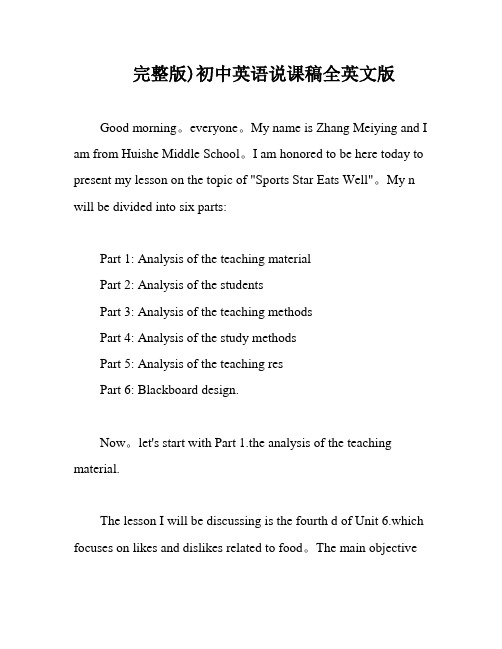
完整版)初中英语说课稿全英文版Good morning。
everyone。
My name is Zhang Meiying and I am from Huishe Middle School。
I am honored to be here today to present my lesson on the topic of "Sports Star Eats Well"。
My n will be divided into six parts:Part 1: Analysis of the teaching materialPart 2: Analysis of the studentsPart 3: Analysis of the teaching methodsPart 4: Analysis of the study methodsPart 5: Analysis of the teaching resPart 6: Blackboard design.Now。
let's start with Part 1.the analysis of the teaching material.The lesson I will be discussing is the fourth d of Unit 6.which focuses on likes and dislikes related to food。
The main objectiveof this lesson is to teach students about the importance of healthy eating habits for sports stars。
To achieve this objective。
we will analyze the following aspects:1.Status and n: The lesson is an integral part of the curriculum and plays a significant role in helping students understand the importance of healthy eating habits for athletes.Let's move on to Part 2.the analysis of the students.Teaching aims and demands include knowledge aims。
- 1、下载文档前请自行甄别文档内容的完整性,平台不提供额外的编辑、内容补充、找答案等附加服务。
- 2、"仅部分预览"的文档,不可在线预览部分如存在完整性等问题,可反馈申请退款(可完整预览的文档不适用该条件!)。
- 3、如文档侵犯您的权益,请联系客服反馈,我们会尽快为您处理(人工客服工作时间:9:00-18:30)。
初中英语说课稿肇州县兴城中学孙立敏一、教材(教材分析)Analyzing teaching material1. 型 lesson type (Dialogue/ reading/ listening/ revision)2. 本在教材中的地位status and functionLesson 33 Saving the Earth is a dialogue. The lesson is focused on the topic of the problems of the earth and the functional items of Supposition/ Intentions/ conjecture/ Prohibition. Since it is a dialogue / reading. Itimprove the Ss communicative/ reading ability.3. 教学指思想teaching guideline(Teaching syllabus: Language is for communication, develop their four skills, lay special emphasis on reading; Grellet put it well in his book developing reading skills: develop reading skill/ discourse analysis; get them to understand the western culture better; improve the ability to discover, analyze & solve the problems; Reading is for information, for fun; Use Top- down model or Bottom- up model to activate Ss schemata; Interactive model) 4. 教学目和要求 Teaching aims and demands (⋯ be intended for Ss in key schools)1)知目knowledge objectsa. Enable the Ss to remember the following new words & phrases:Damage, lecture, pollute, pollution, room, standing room, be fit for, hear about, turn intob. Get the Ss to be familiar with this sentence pattern:If the population keeps growing so quickly, there will only be standing room left ⋯Give the Ss a reinforced practice on the functional item Supposition.c. Activate Ss schemata regarding the topic of pollution and help Ss to know more about the problem of pollution.2)智能目ability objectsa. Ask the Ss to make up a similar dialogue.b. Help them to understand the dialogue better and improve the four skills.c. Develop their ability of thinking independently.d. Cultivate their ability to discover, analyze and solve problems.e. Train them to collect information from the Internet.f. Train them with some effective learning methods to optimize Ss ’ learning results. 3)德育目moral objectsa. Arouse their interest in learning English;b. Help them to understand the background of pollution.c. Enable the students to love our earth and the nature.d. Be aware of the importance of stopping pollution & protecting out environment.e. Encourage the Ss to do something to save the earth.5. 教学重点teaching important points ( 生、句型;培养技能 )a. New words and phrasesb. Sentence pattern: If- clausec. improve their reading skills.d. Talking about problems of the Earth.6. 教学点teaching difficult points ( 法;展交能力 )a. functional item: Supposition.b. Develop their communicative ability. Act out their own dialogue.7. 说教具teaching aids (multi-media computer, software, OHP)The teaching syllabus says that it ’ s necessary for teachers to use modern teaching facilities. It increase the class density and improve our teaching result. It can also make the Ss reach a better understanding of the text by making the classes lively and interesting. At the same time, it arouses the Ss’interest in learning English.二、说教法Teaching methodsFive step method; audio-video; communicative approach;Task-based learning: New Syllabus Design encourages teachers to use this teaching method. TBLT can stimulate Ss’ initiative in learning and develop their ability in language application. Make the Ss the real masters in class while the teacher himself acts as the director and bring their ability into full play.三、说学法Study methods1.Teach Ss how to be successful language learners.2.Teach Ss how to develop the reading skill — skim & scan; how to communicate with others; how to learn new words; how to learn independently;3.Get the Ss to form good learning habits.四、说教学过程Teaching proceduresI.复习 (Revision) 5min (Daily report; 词汇 diagram; brainstorming; activate schemata)Activity 1: Imagination1). Suppose a bottle of ink is turned over and dirties your white shirt, what is to be done? (Wash it? Or throwit away?)2). Suppose you catch a bad cold, what’ s to be done?3). Suppose your bike is broken, what’ s to be done?4). And suppose the earth, on which we all live, is damaged, what’ s to be done?*What can you think of when you see “ pollution this”word?(waste, environment, air, water, factory, desert, climate... Try to activate the Ss schemata regarding the topic of pollution.)II.呈现 (Presentation) 5minActivity 2: PresentationPlay the song“ Earth Song” sung by Michael Jackson. (Create an atmosphere)A lot of pictures and video clips about the causes and results of the three problems mentioned in this lesson will be shown on the screen with the help of the computer.Ss’presentation on pollution. Attract their attention, arouse their interest, and create a good atmosphere for communication.*Activate their schemata and cultivate their ability in collecting information from the Internet and developtheir ability in thinking independently.1.Pre- readingActivity 3: Prediction1st listening/ fast reading, one guided Q to help Ss to get the main idea:What do you think is discussed at the conference?2.While- readingActivity 4: Read and answer2nd listening/ careful reading, more Qs to get the detailed information. Develop their reading skills: skim & scan. Pay attention to the pronunciation, stress & intonation.* 阅读 : Pre-reading; while-reading; post-reading (fast reading/ careful reading; skim/ scan; 识别关键词 key words;确定主题句;创设信息差 information gap ;T or F; 填表格 chart/diagram; Predicting; Make a timeline; Make a story map 。
